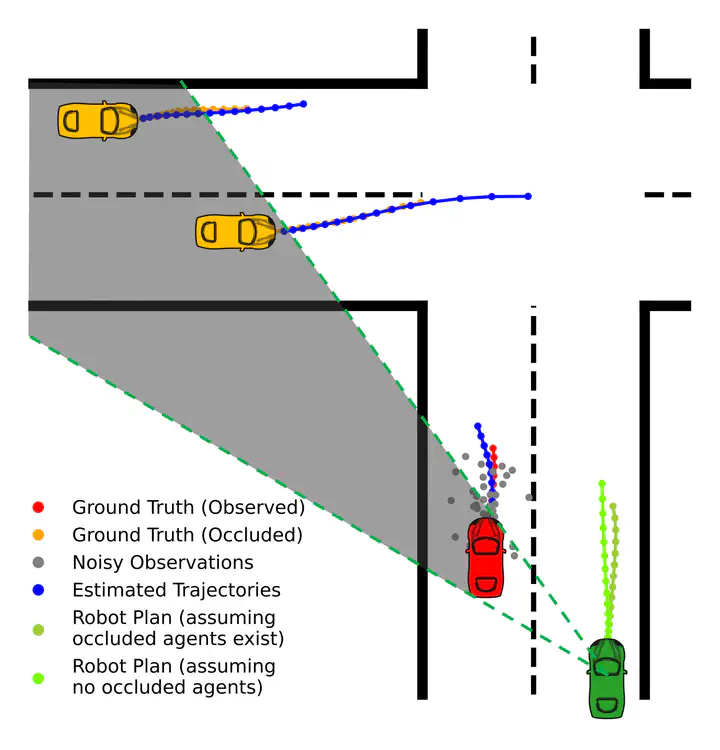 Occlusion-aware contingency game planner in an intersection scenario. The green vehicle can only see the red vehicle in the adjacent lane and is uncertain about the existence of occluded vehicles in the horizontal lanes. The green vehicles makes two assumptions: either 1) occluded vehicles exist. It can then use our proposed approach to estimate their trajectories by observing the red vehicle’s deceleration and plans the dark green trajectory; or 2) there are no occluded vehicles. It then only interacts with the red vehicle and plans the light green trajectory. Our contingency planning approach blends these two alternative strategies, while accounting for the fact that any occluded agents will be visible in the near future as the green vehicle approaches the intersection.
Occlusion-aware contingency game planner in an intersection scenario. The green vehicle can only see the red vehicle in the adjacent lane and is uncertain about the existence of occluded vehicles in the horizontal lanes. The green vehicles makes two assumptions: either 1) occluded vehicles exist. It can then use our proposed approach to estimate their trajectories by observing the red vehicle’s deceleration and plans the dark green trajectory; or 2) there are no occluded vehicles. It then only interacts with the red vehicle and plans the light green trajectory. Our contingency planning approach blends these two alternative strategies, while accounting for the fact that any occluded agents will be visible in the near future as the green vehicle approaches the intersection.Abstract
In mobile robotics and autonomous driving, it is natural to model agent interactions as the Nash equilibrium of a noncooperative, dynamic game. These methods inherently rely on observations from sensors such as lidars and cameras to identify agents participating in the game and, therefore, have difficulty when some agents are occluded. To address this limitation, this paper presents an occlusion-aware game-theoretic inference method to estimate the locations of potentially occluded agents, and simultaneously infer the intentions of both visible and occluded agents, which best accounts for the observations of visible agents. Additionally, we propose a receding horizon planning strategy based on an occlusion-aware contingency game designed to navigate in scenarios with potentially occluded agents. Monte Carlo simulations validate our approach, demonstrating that it accurately estimates the game model and trajectories for both visible and occluded agents using noisy observations of visible agents. Our planning pipeline significantly enhances navigation safety when compared to occlusion-ignorant baseline as well.